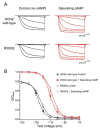Mutation analysis of the hyperpolarization-activated cyclic nucleotide-gated channels HCN1 and HCN2 in idiopathic generalized epilepsy
- PMID: 17931874
- PMCID: PMC2709210
- DOI: 10.1016/j.nbd.2007.08.006
Mutation analysis of the hyperpolarization-activated cyclic nucleotide-gated channels HCN1 and HCN2 in idiopathic generalized epilepsy
Abstract
Hyperpolarization-activated cyclic nucleotide-gated (HCN1-4) channels play an important role in the regulation of neuronal rhythmicity. In the present study we describe the mutation analysis of HCN1 and HCN2 in 84 unrelated patients with idiopathic generalized epilepsy (IGE). Several functional variants were identified including the amino acid substitution R527Q in HCN2 exon 5. HCN2 channels containing the R527Q variant demonstrated a trend towards a decreased slope of the conductance-voltage relation. We also identified a variant in the splice donor site of HCN2 exon 5 that results in the formation of a cryptic splice donor. In HCN1, the amino acid substitution A881T was identified in one sporadic IGE patient but was not observed in 510 controls. Seven variants were examined further in a case-control association study consisting of a larger cohort of IGE patients. Further studies are warranted to more clearly establish the contribution of HCN1 and HCN2 dysfunction to the genetic variance of common IGE syndromes.
Figures




Similar articles
-
Properties of hyperpolarization-activated pacemaker current defined by coassembly of HCN1 and HCN2 subunits and basal modulation by cyclic nucleotide.J Gen Physiol. 2001 May;117(5):491-504. doi: 10.1085/jgp.117.5.491. J Gen Physiol. 2001. PMID: 11331358 Free PMC article.
-
Augmented currents of an HCN2 variant in patients with febrile seizure syndromes.Ann Neurol. 2010 Apr;67(4):542-6. doi: 10.1002/ana.21909. Ann Neurol. 2010. PMID: 20437590 Free PMC article.
-
Activity-dependent heteromerization of the hyperpolarization-activated, cyclic-nucleotide gated (HCN) channels: role of N-linked glycosylation.J Neurochem. 2008 Apr;105(1):68-77. doi: 10.1111/j.1471-4159.2007.05110.x. Epub 2007 Nov 5. J Neurochem. 2008. PMID: 17988239 Free PMC article.
-
HCN channelopathies: pathophysiology in genetic epilepsy and therapeutic implications.Br J Pharmacol. 2012 Jan;165(1):49-56. doi: 10.1111/j.1476-5381.2011.01507.x. Br J Pharmacol. 2012. PMID: 21615728 Free PMC article. Review.
-
HCN channels: structure, cellular regulation and physiological function.Cell Mol Life Sci. 2009 Feb;66(3):470-94. doi: 10.1007/s00018-008-8525-0. Cell Mol Life Sci. 2009. PMID: 18953682 Free PMC article. Review.
Cited by
-
Phosphorylation of the HCN channel auxiliary subunit TRIP8b is altered in an animal model of temporal lobe epilepsy and modulates channel function.J Biol Chem. 2019 Oct 25;294(43):15743-15758. doi: 10.1074/jbc.RA119.010027. Epub 2019 Sep 5. J Biol Chem. 2019. PMID: 31492750 Free PMC article.
-
Suppression of Hyperpolarization-Activated Cyclic Nucleotide-Gated Channel Function in Thalamocortical Neurons Prevents Genetically Determined and Pharmacologically Induced Absence Seizures.J Neurosci. 2018 Jul 25;38(30):6615-6627. doi: 10.1523/JNEUROSCI.0896-17.2018. Epub 2018 Jun 20. J Neurosci. 2018. PMID: 29925625 Free PMC article.
-
HCN channels in behavior and neurological disease: too hyper or not active enough?Mol Cell Neurosci. 2011 Feb;46(2):357-67. doi: 10.1016/j.mcn.2010.11.007. Epub 2010 Dec 3. Mol Cell Neurosci. 2011. PMID: 21130878 Free PMC article. Review.
-
De novo mutations in HCN1 cause early infantile epileptic encephalopathy.Nat Genet. 2014 Jun;46(6):640-5. doi: 10.1038/ng.2952. Epub 2014 Apr 20. Nat Genet. 2014. PMID: 24747641
-
Photoreceptor Ion Channels in Signaling and Disease.Adv Exp Med Biol. 2023;1415:269-276. doi: 10.1007/978-3-031-27681-1_39. Adv Exp Med Biol. 2023. PMID: 37440044
References
-
- Avanzini G, de Curtis M, Pape HC, Spreafico R. Intrinsic properties of reticular thalamic neurons relevant to genetically determined spike-wave generation. Adv Neurol. 1999;79:297–309. - PubMed
-
- Bachmann HS, Siffert W, Frey UH. Successful amplification of extremely GC-rich promoter regions using a novel ‘slowdown PCR’ technique. Pharmacogenetics. 2003;13:759–766. - PubMed
-
- Bender RA, Brewster A, Santoro B, Ludwig A, Hofmann F, Biel M, Baram TZ. Differential and age-dependent expression of hyperpolarization-activated, cyclic nucleotide-gated cation channel isoforms 1–4 suggests evolving roles in the developing rat hippocampus. Neuroscience. 2001;106:689–698. - PMC - PubMed
-
- Bender RA, Soleymani SV, Brewster AL, Nguyen ST, Beck H, Mathern GW, Baram TZ. Enhanced expression of a specific hyperpolarization-activated cyclic nucleotide-gated cation channel (HCN) in surviving dentate gyrus granule cells of human and experimental epileptic hippocampus. J Neurosci. 2003;23:6826–6836. - PMC - PubMed
-
- Blumenfeld H. Cellular and network mechanisms of spike-wave seizures. Epilepsia. 2005;46 (Suppl 9):21–33. - PubMed
Publication types
MeSH terms
Substances
Grants and funding
LinkOut - more resources
Full Text Sources
Molecular Biology Databases

